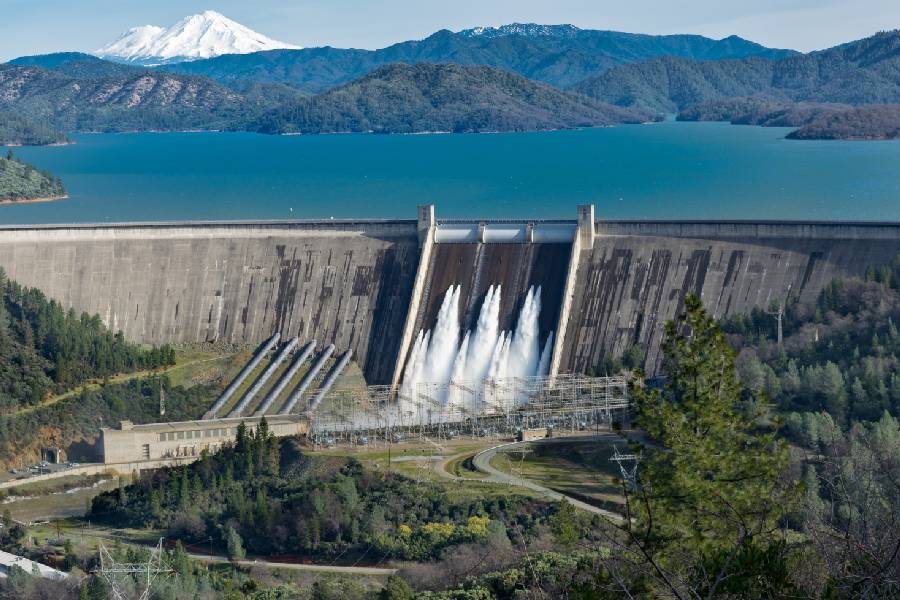Water – it sustains life, powers economies, and sometimes rages out of control. Understanding water’s movement and impact is the domain of hydrology, a crucial discipline for our civil engineers at Cypress Environment & Infrastructure. In this article, we’ll explore what is hydrology in civil engineering and why it’s integral to infrastructure and the environment.
We’ll explain concepts like the hydrologic cycle and water balance, giving context to the different phases and transitions of water. We’ll also discuss how our engineers analyze data like rainfall intensity, flooding frequency, and water quality. You’ll gain insight into modeling tools hydrologists use to inform engineering and policy decisions.
Applications of hydrology range from designing dams and canals to managing wetlands and predicting floods. By the end, you’ll appreciate this complex science focused on water – the most vital substance on Earth. From theory to practice, hydrology empowers civil engineers to master water’s movements.

The Basics of Hydrology
In the world of civil engineering, hydrology is the fundamental science that explores the movement, distribution, and quality of water on Earth. To comprehend the role of hydrology in civil engineering, we must first grasp the essential principles that govern the behavior of water within our environment.
Understanding the hydrological cycle
At the heart of hydrology lies the hydrological cycle, a continuous and intricate process that orchestrates the movement of water on our planet. The hydrologic cycle starts with water evaporating from the Earth’s surface. This evaporation mostly occurs in oceans, lakes, and rivers, driven by the sun’s energy.
This water vapor rises into the atmosphere and eventually condenses into clouds. When the conditions are right, this condensed water falls back to the Earth as precipitation in the form of rain, snow, sleet, or hail.
From here, water follows various paths. Some of it flows directly into rivers and streams, while some infiltrates the ground to become groundwater. Much of the water that reaches the ground’s surface will eventually flow into rivers and find its way back to the oceans.
This continuous cycle, which may take minutes or centuries for a single drop of water to complete the hydrological cycle, is the foundation of all hydrological processes and is vital for civil engineers to understand as they plan and manage water-related projects.
Precipitation, evaporation, and runoff
The hydrological cycle can be dissected into specific processes. Precipitation refers to any form of water, liquid or solid, that falls from the atmosphere to the Earth’s surface. It is the primary input into the hydrological system.
After precipitation, water can follow several paths. Some of it will evaporate back into the atmosphere, especially in regions with intense sunlight and heat. The remainder either percolates into the ground to become groundwater or runs off the surface, creating surface water flow in rivers and streams.
Key Concepts in Hydrology
Hydrology is a complex field that involves several key concepts. Each of these plays a vital role in understanding and managing water resources. In this section, we explain the concepts to provide a solid foundation for hydrology in civil engineering.
Precipitation
Precipitation is a fundamental hydrological process that refers to any form of water – liquid or solid – falling from the sky onto the Earth’s surface. This includes rain, sleet, snow, and hail. Understanding precipitation is crucial in hydrology for several reasons:
- Water input – Precipitation is the primary source of freshwater input to the Earth’s surface. It replenishes rivers, lakes, and groundwater reserves, providing the essential water supply for ecosystems and human activities.
- Hydrological cycle – Precipitation is a key driver of the hydrological cycle. It initiates the process by which water evaporates, condenses into clouds, and then falls back to the Earth’s surface. This cycle is critical for maintaining water balance and supporting life on Earth.
- Flood management – Excessive or intense precipitation can lead to flooding, making it essential to monitor and predict precipitation patterns. This is especially significant for flood management and early warning systems to protect communities and infrastructure.
Runoff
Runoff is the flow of water on the Earth’s surface, typically occurring after precipitation. It refers to water that does not infiltrate into the ground but moves across the surface, eventually reaching rivers, streams, and other bodies of water. Runoff is a critical concept in hydrology for several reasons:
- Flood management – Runoff is a primary factor contributing to flooding. Understanding runoff patterns and volumes is essential for flood management and the design of effective flood control measures.
- Water resource planning – The management of water resources, including their allocation and distribution, depends on an accurate assessment of runoff. This is particularly important for ensuring a sustainable and reliable water supply for communities and agriculture.
Evaporation and transpiration
Evaporation and transpiration are processes by which water returns to the atmosphere from the Earth’s surface. Evaporation is the conversion of liquid water into water vapor, while transpiration is the release of water vapor by plants. These processes are crucial in hydrology for several reasons:
- Hydrological modeling – Understanding evaporation and transpiration is vital for hydrological modeling. These processes affect the availability of water for other purposes and play a key role in calculating water balances.
- Ecosystems – Evaporation and transpiration are essential for ecosystems. They contribute to the Earth’s climate, influence weather patterns, and sustain vegetation. These processes also regulate temperature and humidity.

Groundwater
Groundwater is the water stored beneath the Earth’s surface in underground aquifers. It is a vital component of the Earth’s water cycle and has significant relevance in hydrology for various reasons:
- Water supply – Groundwater serves as a critical source of freshwater for drinking, irrigation, and industrial purposes. Understanding the availability and sustainability of groundwater is essential for water supply planning.
- Ecosystems – Groundwater plays a role in sustaining ecosystems by providing base flow to rivers and streams, even during dry periods. This is crucial for preserving aquatic habitats.
- Environmental impact – Groundwater quality and levels can be affected by human activities, such as agriculture and industry. Hydrologists and civil engineers work together to manage and protect this vital resource.
Application of Hydrology in Civil Engineering
At Cypress, we see hydrology as not just a theoretical science but a practical discipline with numerous applications. It plays a pivotal role in addressing water-related challenges and making informed decisions to create sustainable infrastructure. Let’s look at some of the key applications of hydrology in civil engineering:
Urban drainage
Urban areas face unique challenges related to water management, including stormwater runoff, sewage systems, and flood control. Hydrology is integral to urban drainage systems for several reasons:
- Stormwater management – Urbanization often leads to increased impervious surfaces, which can result in rapid stormwater runoff. Hydrologists work with civil engineers to design effective stormwater management systems, including retention basins, underground storage, and permeable pavements, to prevent urban flooding.
- Sewage systems – Hydrology is essential for the design of sewage and wastewater systems in cities. Understanding flow rates, water quality, and treatment processes is crucial for maintaining clean and functional urban environments.
Water resources management
One of the primary applications of hydrology in civil engineering is the management of water resources. This includes the allocation and sustainable use of water. This is particularly significant for a variety of reasons:
- Water supply – Hydrologists and civil engineers collaborate to ensure a reliable water supply for urban and rural communities. This includes the assessment of water sources, the development of reservoirs, and the design of distribution systems.
- Agriculture – Agriculture relies heavily on water resources, and hydrology plays a role in optimizing irrigation systems. Proper water management in agriculture ensures efficient water use, crop productivity, and sustainability.
Flood risk assessment
Hydrology is a critical tool for assessing and managing flood risks, particularly in regions prone to heavy rainfall, snowmelt, or tropical storms. Flood risk assessment is essential for several reasons:
- Infrastructure protection – Civil engineers use hydrological data to design infrastructure capable of withstanding floods. This includes embankments, levees, and stormwater management systems.
- Early warning systems – Hydrology contributes to the development of early warning systems, which can save lives and property by providing advance notice of impending floods. These systems rely on rainfall and river flow data to predict flood events.
- Floodplain management – Hydrology helps land-use planners identify flood-prone areas. By mapping floodplains and understanding flood patterns, civil engineers and urban planners can reduce risks and minimize damage.
Hydrology in civil engineering is a dynamic field with real-world applications that contribute to safer and more sustainable urban environments, efficient water resource management, and effective flood risk mitigation. It is an invaluable tool that enhances the quality of life for communities around the world.

Conclusion
What is hydrology in civil engineering? We’ve uncovered the significance of understanding water’s behavior, from the moment it falls as precipitation to its vital part in groundwater aquifers. These concepts are the bedrock of flood prediction, water resource planning, and maintaining ecosystems.
In civil engineering, hydrology is not a mere academic exercise; it’s an actual tool. We’ve delved into its applications, from urban drainage to water resource management and flood risk assessment.
By monitoring runoff and precipitation patterns, our hydrologists and engineers ensure safer and more sustainable environments for us all. Hydrology is the linchpin between science and practice, driving urban development, water supply planning, and early flood warnings.
As the global community grapples with water-related challenges, it’s clear that hydrology is an indispensable part of the solution. This dynamic discipline empowers civil engineers to protect communities, support agriculture, and enhance the quality of life.
